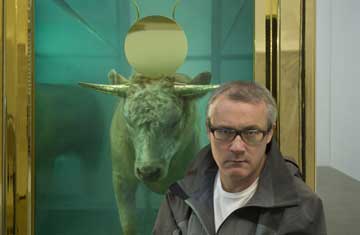Art gets into the national news in the UK in four ways. One: a publically funded institution decides to purchase something of apparent worthlessness (a ‘pile of bricks,’ a can of poo) with taxpayers’ money. Two: privately owned works of art on public display are put up for sale and the public is asked to help ‘save’ them through a national appeal. Three: the international auction price for a work of art reaches unprecedentedly astronomical heights. And now there’s a fourth: an artist decides to sidestep the gallery system altogether and sell new works directly at an auction house, leaving the dealers by the wayside.
Damien Hirst’s sale (titled ‘Beautiful Inside My Head Forever,’ like an exhibition), which takes place at Sotheby’s in London on Monday and Tuesday evening, is either the death-knell for the gallery system or a predictably unorthodox approach from an artist whose work is so unrepresentative of most contemporary art that it demands its own particular form of critical language. Hirst’s supporters reach for the Old Testament when defending his work, which is appropriate for an artist whose work makes apparently unironic reference to biblical parable (imagine discussing Tomma Abts or Kara Walker or even Matthew Barney in a similar way and you can see the point). The Golden Calf, the centerpiece of his Sotheby’s display, is practically an illustration of Aaron’s sacrilegious statue cast from the molten jewelery of the Israelites. Hirst’s work is more or less what it sounds like: a whole calf pickled in formaldehyde with golden hooves, horns, and a gold disc lodged in its forehead in a gold-plated vitrine atop a Carrara marble plinth. If that sounds like a prop from a Queen backstage party in the late 70s, it’s appropriate: ever since his diamond-studded skull (For The Love of God) and its accompanying security frenzy, Hirst has embraced the grandiloquent pretensions of his loyal supporters, the oligarchs and hedge-funders who are the only people not squeezed out of the bidding by his extraordinary price-tags (the relative paucity of significant Hirsts in public collections is testament to that). The appeal is obvious: you get what you pay for. Gold and diamonds equal expensive, death and mortality equal important themes, big art equals good art. Hirst’s prices have a perverse logic that would appeal to the dulled wits of the 19th century French salon who held that paintings of classical heroism and tragedy must be more important than still-lifes because they’re, like, big pictures about big stuff.
Hirst is still the (British) public’s go-to guy for the definition of modern art: a bit shocking, a bit gruesome, easy to describe in a few words (‘shark in a tank’ – try doing that with Martin Puryear), high-concept and high-gloss. For good or bad, he makes art of our time: iconic works that withstand the buffetings of international communication, able to retain their power across all information streams. Hirst’s art lives in the head as much as in the gallery, and for art to do that, at this moment in history, is an achievement in itself. And while his inverse snobbery is absurd and ill-founded (selling works at prices inaccessible to any museum’s acquisitions budget isn’t exactly sticking it to the man, however radical the implications of the sale), it’s true that Hirst is a genuinely popular and (in the best possible way) populist artist whose works are comprehensible to a far wider public than that of most of his contemporaries. Don’t get what the shark is about? Read the title: The Physical Impossibility of Death in the Mind of Someone Living. (This is not Untitled Number 243). The hope is that Hirst will become a gateway drug for viewers hankering after something more reflective and substantial (Paul Thek, Sol LeWitt, Joseph Beuys, or any number of other artists to whom Hirst owes a substantial debt). The fear is that most of his best work (and there is more than a handful) will be invisible to the public and turn into a series of one-liners from a bygone past, signifiers of mad wealth without a life beyond the funny pages.
